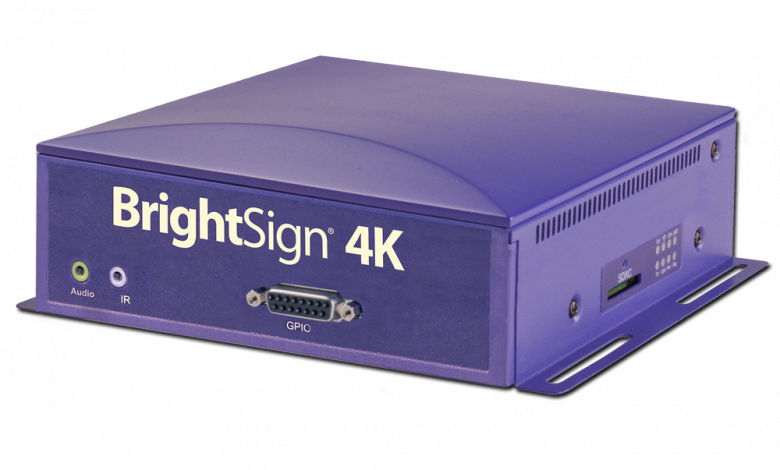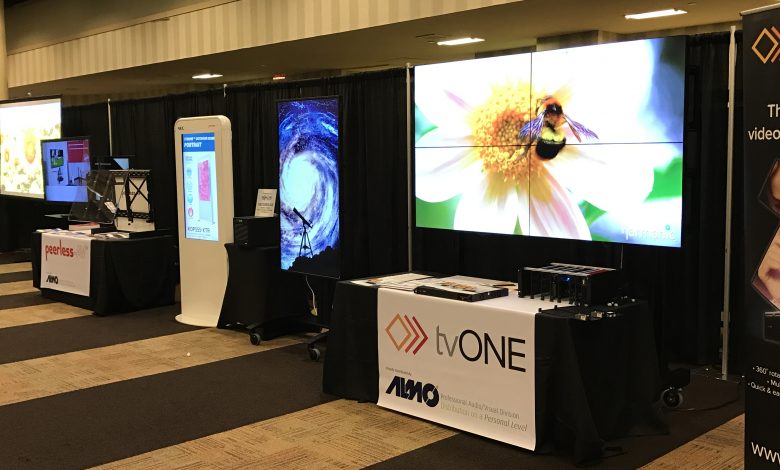Let’s face it, technology keeps us moving forward. It stimulates competition, it influences buying decisions, and it generates new ideas. No example may be more prevalent than the high-definition advances in digital display screens.
Digital signage has embraced high-definition technology, creating a user experience that is unlike anything seen in the past. We’ve can view content in clear, sharp imagery, allowing for truly effective messaging. And today, this technology extends beyond previous limits of “high definition” all the way to “ultra-high definition.” We are now in the realm of 4K resolution.
But what does it mean? Well, 4K resolution basically refers to a horizontal screen display resolution in the order of 4,000 pixels. The previous high-definition standard stood at just over 1,000 pixels (1080p).
“4K is obviously much sharper than 1080p. In the space that a 1080p TV holds a single pixel, a 4K display of the same size can hold four. That makes for a significant jump in clarity,” states David Pratt, director of strategic accounts at Optec Displays.
Making the Case for 4K
There are several elements to that go into an effective digital sign, including image quality, price, compatibility, and content distribution. Sign makers should convey the pluses and minuses of each of these to their customers. Here we take a deeper dive into some of the reasons a sign maker would consider offering 4K displays for a digital signage project.
Image Quality-Let’s start with the obvious advantage of 4K technology, the resolution. Fundamentally, when you increase the number of pixels, you gain more detail resulting in higher image quality.
“To achieve 4K, the density of the pixels within the LCD panel itself needed to increase,” says Cindy McCullough, product marketing manager at Planar, a Leyard Company. “Today’s standard resolution is 1080p. 4K requires four times the pixels.”
In turn, there arises more opportunity to include increased data, features and more.
“4K has enough pixels to fill four full HD 1080p screens,” explains Pratt. “With four times the number of pixels it’s able to display four times the level of detail and even more visual impact. Additionally, traditional HD is limited to 1920 vertical columns and 1080 horizontal rows of pixels, 4K has a total resolution of 3840 vertical pixels x 2160 horizontal pixels.”
This also means that 4K content can be generated in a way that “makes the display appear more life-like and enables content creators to engage the viewers at a higher level,” says Todd Heberlein, business development manager, Almo Professional A/V.
McCullough adds that proximity plays no factor in altering the picture quality, offering “an immersive display experience and clarity and detail that appears sharp even at close viewing distances with no detail missed.”
Price-Because of their relative newness and qualities, it’s no surprise that 4K displays tend to fall on the high end of the pricing spectrum.
“A 4K LED display will be more expensive than lower resolutions because it has more pixels,” says Pratt. “However, as production quantities and demand increase as well as the continued innovations in pixel technology, the costs will decrease.”
McCullough has noticed a dip in costs of late, stating that the price in standard resolution and 4K is narrowing. “4K resolution has already started to come down in price,” she says.
The trend in consumer demand for 4K technology has helped the commercial side along. As Heberlein explains, “4K has become the standard in consumer displays. This has driven the cost down over time so that the cost difference in a comparable 4K and 1080p 55″ TV (if you can even find one), is almost negligible. This is not yet the case with commercial displays. Because the commercial space is a little slower to adopt 4K technology, the cost is still significantly different for many manufacturers.”
It may take some time for each manufacturer to land on a price as they find their footing in the market, however.
“As we see more 4K content being introduced into commercial environments, I believe we will see the same trend as in the consumer space,” Heberlein says.
Pratt goes on to explain that regardless of price, it is “important to review your display requirements with your sign/display dealer and integrator to ensure you’re getting the solution that’s right for you.”
Compatibility-Of course, whenever there is a new technological advancement, we must be certain that other elements work seamlessly with the latest solution. (Take a new cell phone and an old charger, for example, they aren’t always compatible.) It’s no different with the arrival of 4K screen technology.
“The digital media, the physical media, and the connection between devices and the display all need to be up to the task of showing 4K content,” says Pratt.
The connection is one area in which a solution now exists.
“One major step display manufacturers have taken is to allow for 4K to be transmitted/received over one cable,” says Heberlein. “Since consumer displays drive the economies of scale, it became an undertaking for the group that implements HDMI standards. The current HDMI standard of HDMI 1.3 was only capable of transmitting a maximum resolution of 2560 × 1440, and since 4K resolution started at 3840 x 2160, some changes had to be made. In May 2009, the standard HDMI 1.4 was released, which allowed for resolution up to 4096 x 2160. Shortly after that time, both consumer and commercial 4K products started to be released.”
In addition to HDMI standards, the issue of handling content is another element that needs to be considered.
“4K content requires substantially higher data rates than 1080p content. As a result, the existing H.264 / AVC compression algorithm traditionally used on various 1080p content can’t meet the necessary compression ratios to show the 4K streamed content on various media players at 60Hz,” says McCullough, alluding to Advanced Video Coding (AVC) versus High Efficiency Video Coding (HEVC). “Many players require the H.265 / HEVC algorithm to be used for 4K content instead, which delivers 4K streamed content at 60Hz, as it can achieve 25 to 35 percent lower bit rates and with better image quality. When creating your own 4K video content, be sure to use HEVC whenever it’s supported by your hardware platform.”
Content-Building on what McCullough described regarding video content, outside of data rate concerns, 4K is able to handle a wide variety of content.
“While 4K can handle any type of content like other displays, PC applications dominate as content providers, as video graphics cards have supported 4K output for quite some time,” says Pratt.
Pratt mentions Apple TV as a driver of more 4K content to users, as well as the growing number of devices that can video record at 4K.
“While movie companies shoot in 4K and greater,” he continues, “the resolution exists but the file size is too large to distribute, and the required bandwidth can strain delivery systems such as the internet; however, that’s changing.”
“Another challenge,” Heberlein adds, “was to produce items that could manage and distribute the 4K content, including the technology that allows the same UHD signal to be compressed and sent over a network cable for long distance transmissions. This is especially important in the commercial space, where AV signal management hardware is commonly located hundreds of feet from the 4K displays being used.”
Streaming services are also an option for providing content to 4K displays, and Heberlein mentions “manufacturers like BrightSign have 4K media players capable of playing 4K digital signage.”
Applying 4K Technology
As sign makers, it’s important to know what environment suits 4K technology best. Though it’s true that there is a movement toward 4K replacing other high-definition options, some users are slower than others in adopting the technology. This group may be resisting the changeover to 4K until the last possible moment.
But for those who are making the switch, many employ “detail-oriented displays and content ideal for 4K,” says McCullough. “Anything from maps, directories to sophisticated and detailed imagery are ideal for 4Ks. The colors and details will be clearer and crisper with a 2160p/4K resolution display.”
Pratt admits that this isn’t a “one-size-fits-all solution” and that, “understanding markets and application requirements and knowing where 4K provides the most benefits is critical. Not every application,” he continues, “will need or require 4K resolution. Where it is really advantageous is with a shorter-than-usual viewing distance and for displaying complex, high-resolution content.”
For a more specific example of an application, Heberlein offers that “currently, the biggest push for 4K signage is in retail applications, especially in jewelry stores and high-end clothing retailers. The high resolution draws the viewer in and creates the emotional response that marketing teams look for.”
The reason for the popularity of 4K in these situations goes back to resolution-the ability to pack more pixels into an image.
“All those available pixels per inch smooth text on the screen and deliver granular levels of detail,” explains Pratt. “When a person is close to a standard HD, individual pixels and the gaps between them can be seen. However, this doesn’t occur with 4K.”
Both Pratt and Heberlein agree that these details are helpful with applications such as mapping where a screen can be zoomed in-or even with aerial footage or satellite images.
“It’s also ideal for showing complex seamless systems, such as subway lines, power grids, and pipe lines, as well as television broadcasts and high-resolution screening rooms,” says Pratt.
What’s Next?
Before we know it, 4K won’t be the new kid on the block anymore and some other new-fangled technological wave will jump ahead of it. In fact, even today there are hints of the next generation of digital screen resolution.
“We have already seen the introduction of 8K and even 10K,” notes Heberlein. “These are very limited in their offerings, and will continue to be so until both content and the economies of scale bring the pricing down considerably.”
Pratt cites a report from Delaware-based Global Market Insights stating that “the market for 4K display panels is expected to surpass $44 billion by 2024. That said, 8K is emerging from prototype to production and we should see these displays entering the market soon. At a resolution of 7680 x 4320 (or 4,320p), 8K is four times the resolution of 4K Ultra HD and 16 times that of 1080p. It might seem mind-boggling, but it’s a technology that already exists, and manufacturers are already playing around with it.”
The technology continues to be developed because of the clamoring for the best quality, the clearest imagery, and the most functional screen displays.
“Demand for high resolution across all displays is on the rise and attention is focused on the 8K ecosystem ahead,” adds McCullough. “Unfortunately, the high data rate required for connectivity makes achieving 8K resolution complicated. An 8K image may display up to 120 frames per second (fps), require a minimum of 10-bit color, and require the color sub-sampling 4:4:4, 4:2:2, or 4:2:0. This requires significant compression to distribute.”
So, let’s not get too far ahead of ourselves. Right now, 4K is a highly advanced, extremely useful technology in this industry.
As Pratt states, “4K content is becoming increasingly desirable for retail digital signage applications because of the wow-factor effect it has on consumers, especially when they’re viewing products or product application details. While 4K digital sign will display content in a vivid light, the graphics will look amazing. 4K will capture attention, whether walking through an indoor store aisle or when from a far distance.”
Today, as we enter the realm of 4K resolution, we are seeing some very advantageous benefits for users and viewers of screens. Sign makers should see this as a great opportunity to include this technology as part of a digital signage solution for years to come.







